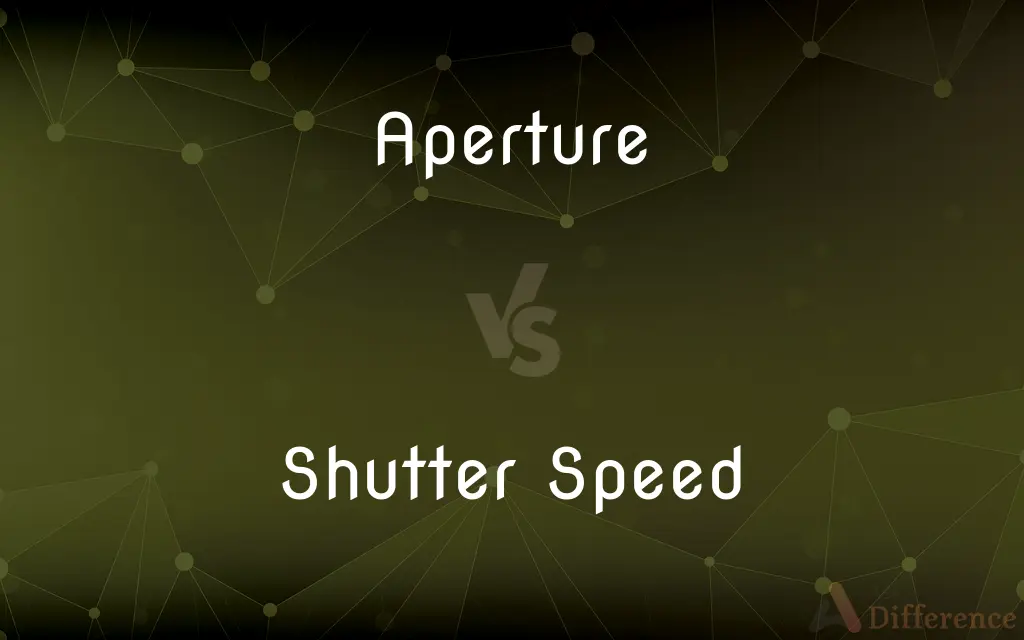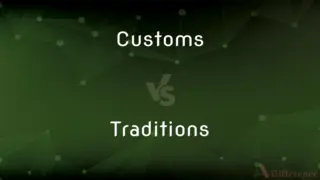Aperture vs. Shutter Speed — What's the Difference?
By Tayyaba Rehman & Fiza Rafique — Published on February 16, 2024
Aperture controls the lens's opening size, affecting depth of field and light intake. Shutter speed determines how long the camera's shutter is open, influencing exposure and motion blur.

Difference Between Aperture and Shutter Speed
Table of Contents
ADVERTISEMENT
Key Differences
Aperture and shutter speed are fundamental concepts in photography, each playing a crucial role in exposure control and artistic expression. Aperture refers to the size of the opening in the lens through which light enters the camera. It is measured in f-stops, with lower numbers representing larger openings. A wider aperture (e.g., f/2.8) allows more light to reach the camera's sensor, making it ideal for low-light conditions. It also creates a shallower depth of field, which blurs the background and highlights the subject, useful in portrait photography.
Shutter speed, on the other hand, dictates the duration the camera's shutter remains open to expose the sensor to light. It is typically measured in seconds or fractions of a second. Faster shutter speeds (e.g., 1/1000th of a second) freeze motion, perfect for capturing fast-moving subjects without blur. Slower shutter speeds (e.g., 1 second) allow more light in and can create a motion blur effect, which is often used creatively to convey movement, such as in waterfall photography.
The interplay between aperture and shutter speed is a balancing act in achieving the desired exposure. A larger aperture allows for a faster shutter speed, useful in action photography, while a smaller aperture might necessitate a slower shutter speed, risking motion blur if not stabilized. Photographers often adjust both settings in tandem to achieve the correct exposure without compromising their artistic vision.
While aperture impacts the depth of field and the amount of light entering the lens, shutter speed affects the exposure time and the portrayal of motion. Both elements are part of the exposure triangle, along with ISO, and understanding how to manipulate them is essential for both technical proficiency and creative expression in photography.
In summary, while aperture and shutter speed serve the shared goal of exposure control, they offer distinct creative controls—aperture affects depth of field and light intake, while shutter speed controls motion capture and exposure time, making them indispensable tools in the photographer's toolkit.
ADVERTISEMENT
Comparison Chart
Primary Function
Controls the size of the lens opening
Controls the duration of light exposure
Measured In
F-stops (e.g., f/2.8, f/16)
Seconds or fractions of a second (e.g., 1/500s, 1s)
Affects
Depth of field, amount of light
Motion blur or freeze, amount of light
Creative Use
Blurring backgrounds, focus control
Freezing action, creating motion blur
Low-Light Utility
Larger apertures (lower f-stop) gather more light
Slower speeds allow more light but risk blur
Compare with Definitions
Aperture
The opening in a lens that controls light entry.
Adjusting the aperture helped capture the candlelit scene.
Shutter Speed
Measured in seconds or fractions thereof.
I used a 1/1000 second shutter speed for the sports event.
Aperture
Measured in f-stops, affecting depth of field.
A lower f-stop aperture blurred the background beautifully.
Shutter Speed
Critical for balancing light and motion in photography.
Adjusting shutter speed helped balance the bright daylight exposure.
Aperture
Larger apertures allow more light, useful in dim settings.
I opened the aperture to photograph the starry night.
Shutter Speed
The time the camera shutter is open to expose the sensor.
A fast shutter speed captured the hummingbird in flight.
Aperture
Affects the sharpness of backgrounds and foregrounds.
The wide aperture isolated the subject from its surroundings.
Shutter Speed
Controls motion blur and exposure in an image.
Slowing the shutter speed turned the waterfall into a silky flow.
Aperture
An opening, such as a hole, gap, or slit.
Shutter Speed
Faster speeds freeze action, slower speeds convey motion.
The slow shutter speed blurred the cars' lights on the highway.
Aperture
A usually adjustable opening in an optical instrument, such as a camera or telescope, that limits the amount of light passing through a lens or onto a mirror.
Aperture
The diameter of such an opening, often expressed as an f-number.
Aperture
The diameter of the objective of a telescope.
Aperture
A small or narrow opening, gap, slit, or hole.
An aperture in a wall
Piriform aperture
Aperture
(optics) A hole which restricts the diameter of the lightpath through one plane in an optical system.
Aperture
The diameter of such a hole which restricts the width of the lightpath through the whole system. For a telescope, this is the diameter of the objective lens.
Angular aperture
This telescope has a 100 cm aperture.
Aperture
The (typically) large-diameter antenna used for receiving and transmitting radio frequency energy containing the data used in communication satellites, especially in the geostationary belt. For a comsat, this is typically a large reflective dish antenna; sometimes called an array.
Aperture
The maximum angle between the two generatrices.
If the generatrix makes an angle θ to the axis, then the aperture is 2θ.
Aperture
The act of opening.
Aperture
An opening; an open space; a gap, cleft, or chasm; a passage perforated; a hole; as, an aperture in a wall.
An aperture between the mountains.
The back aperture of the nostrils.
Aperture
The diameter of the exposed part of the object glass of a telescope or other optical instrument; as, a telescope of four-inch aperture.
Aperture
A device that controls amount of light admitted
Aperture
A natural opening in something
Aperture
An man-made opening; usually small
Aperture
Integral to achieving the desired exposure and focus.
Choosing the right aperture was key to the portrait's clarity.
Common Curiosities
Can I use a fast shutter speed in dim conditions?
Yes, but it may require a wider aperture or higher ISO.
Can aperture affect image sharpness?
Yes, smaller apertures (higher f-stops) can increase overall sharpness.
How do I prevent motion blur with slow shutter speeds?
Use a tripod or image stabilization features.
Is it possible to adjust aperture on all cameras?
Most DSLRs and mirrorless cameras allow manual aperture control.
Does a smaller aperture number mean more light?
Yes, smaller f-stop numbers indicate larger apertures.
What's the best aperture for landscape photography?
Smaller apertures (e.g., f/8 to f/16) for greater depth of field.
Can slow shutter speeds be used for creative effects?
Yes, they're great for creating light trails and smooth water effects.
What's the relationship between aperture, shutter speed, and ISO?
They form the exposure triangle, each affecting image brightness and quality.
Can I change shutter speed on a smartphone camera?
Many smartphones offer manual modes or apps for such adjustments.
How do I choose the right shutter speed for moving subjects?
Start with 1/500s for moderate action, adjusting based on the speed.
Which is better for low light, wide aperture or slow shutter speed?
Wide aperture is often preferred to avoid motion blur.
Do aperture and shutter speed affect ISO settings?
Yes, balancing all three is essential for proper exposure.
Does changing aperture change exposure?
Yes, larger apertures increase exposure by letting in more light.
How does shutter speed affect video recording?
It influences motion blur, with a rule of thumb being 1/(2x frame rate).
How do I balance aperture and shutter speed in manual mode?
Adjust based on lighting conditions and desired depth of field or motion effect.
Share Your Discovery

Previous Comparison
Agarose Gel Electrophoresis vs. Polyacrylamide Gel Electrophoresis
Next Comparison
Customs vs. TraditionsAuthor Spotlight
Written by
Tayyaba RehmanTayyaba Rehman is a distinguished writer, currently serving as a primary contributor to askdifference.com. As a researcher in semantics and etymology, Tayyaba's passion for the complexity of languages and their distinctions has found a perfect home on the platform. Tayyaba delves into the intricacies of language, distinguishing between commonly confused words and phrases, thereby providing clarity for readers worldwide.
Co-written by
Fiza RafiqueFiza Rafique is a skilled content writer at AskDifference.com, where she meticulously refines and enhances written pieces. Drawing from her vast editorial expertise, Fiza ensures clarity, accuracy, and precision in every article. Passionate about language, she continually seeks to elevate the quality of content for readers worldwide.
















































